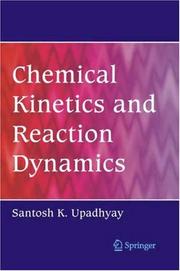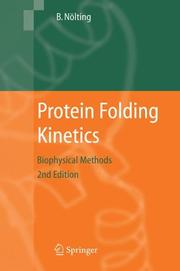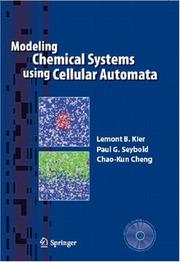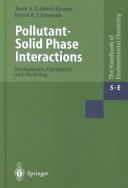| Listing 1 - 10 of 10 |
Sort by
|
Periodical
ISSN: 16083210 00231584
Abstract | Keywords | Export | Availability | Bookmark
 Loading...
Loading...Choose an application
- Reference Manager
- EndNote
- RefWorks (Direct export to RefWorks)
Catalysis --- Chemical kinetics --- Catalyse --- Cinétique chimique --- Périodiques. --- Chemical reaction, Kinetics of --- Chemical reaction, Rate of --- Chemical reaction, Velocity of --- Chemical reaction rate --- Chemical reaction velocity --- Kinetics, Chemical --- Rate of chemical reaction --- Reaction rate (Chemistry) --- Velocity of chemical reaction --- Chemical affinity --- Reactivity (Chemistry)

ISBN: 1280852100 9786610852109 1402045476 1402045468 9048171466 Year: 2006 Publisher: New York : Springer,
Abstract | Keywords | Export | Availability | Bookmark
 Loading...
Loading...Choose an application
- Reference Manager
- EndNote
- RefWorks (Direct export to RefWorks)
Chemical Kinetics and Reaction Dynamics Santosh K. Upadhyay Chemical Kinetics and Reaction Dynamics brings together the major facts and theories relating to the rates with which chemical reactions occur from both the macroscopic and microscopic point of view. This book helps the reader achieve a thorough understanding of the principles of chemical kinetics and includes: Detailed stereochemical discussions of reaction steps Classical theory based calculations of state-to-state rate constants A collection of matters on kinetics of various special reactions such as micellar catalysis, phase transfer catalysis, inhibition processes, oscillatory reactions, solid-state reactions, and polymerization reactions at a single source. The growth of the chemical industry greatly depends on the application of chemical kinetics, catalysts and catalytic processes. This volume is therefore an invaluable resource for all academics, industrial researchers and students interested in kinetics, molecular reaction dynamics, and the mechanisms of chemical reactions.
Chemical reactions. --- Chemical kinetics. --- Chemical reaction, Kinetics of --- Chemical reaction, Rate of --- Chemical reaction, Velocity of --- Chemical reaction rate --- Chemical reaction velocity --- Kinetics, Chemical --- Rate of chemical reaction --- Reaction rate (Chemistry) --- Velocity of chemical reaction --- Chemical affinity --- Reactivity (Chemistry) --- Reactions, Chemical --- Chemical processes --- Chemistry, Physical organic. --- Catalysis. --- Physical Chemistry. --- Activation (Chemistry) --- Chemistry, Physical and theoretical --- Surface chemistry --- Chemistry, Physical organic --- Chemistry, Organic --- Physical chemistry. --- Chemistry, Theoretical --- Physical chemistry --- Theoretical chemistry --- Chemistry

ISBN: 0387259724 0387246495 1441937587 Year: 2005 Publisher: New York, NY : Springer US : Imprint: Springer,
Abstract | Keywords | Export | Availability | Bookmark
 Loading...
Loading...Choose an application
- Reference Manager
- EndNote
- RefWorks (Direct export to RefWorks)
This textbook contains all the information needed for graduate students or industrial researchers to design kinetic experiments involving heterogeneous catalysts, to characterize these catalysts, to acquire valid rate data, to verify the absence of mass (and heat) transfer limitations, to propose reaction models, to derive rate expressions based on these models and, finally, to assess the consistency of these rate equations. Langmuir, Freundlich, and Temkin isotherms are derived and the former are used in Langmuir-Hinshelwood (and Hougen-Watson) models, as well as reaction sequences without a rate-determining step, to obtain rate expressions on uniform surfaces. In addition, rate equations based on non-uniform (Temkin-type) surfaces are examined as an alternative approach. The most recent technique to calculate heats of adsorption and activation barriers on metal surfaces, the BOC-MP approach, is discussed in detail. Methods to measure metal surface areas and crystallite sizes using x-ray diffraction, transmission electron microscopy and various chemisorption techniques are discussed. Different experimental techniques to determine the influence of mass transfer limitations, especially within the pores of a catalyst, are reviewed in detail, with a particular emphasis on liquid-phase reactions. Many illustrations of these and other topics are provided along with numerous problems and a Solutions Manual for instructors. This book will be applicable to any graduate course in chemical engineering, chemistry or materials science that involves kinetics of catalytic reactions, including those catalyzed by enzymes.
Catalysis. --- Chemical kinetics. --- Activation (Chemistry) --- Chemistry, Physical and theoretical --- Surface chemistry --- Chemical reaction, Kinetics of --- Chemical reaction, Rate of --- Chemical reaction, Velocity of --- Chemical reaction rate --- Chemical reaction velocity --- Kinetics, Chemical --- Rate of chemical reaction --- Reaction rate (Chemistry) --- Velocity of chemical reaction --- Chemical affinity --- Reactivity (Chemistry) --- Chemistry, inorganic. --- Chemistry, Physical organic. --- Chemical engineering. --- Inorganic Chemistry. --- Physical Chemistry. --- Industrial Chemistry/Chemical Engineering. --- Chemistry, Industrial --- Engineering, Chemical --- Industrial chemistry --- Engineering --- Chemistry, Technical --- Metallurgy --- Chemistry, Physical organic --- Chemistry, Organic --- Inorganic chemistry --- Chemistry --- Inorganic compounds --- Inorganic chemistry. --- Physical chemistry. --- Chemistry, Theoretical --- Physical chemistry --- Theoretical chemistry
Book
ISBN: 038728690X 0387259732 Year: 2005 Publisher: New York : Springer,
Abstract | Keywords | Export | Availability | Bookmark
 Loading...
Loading...Choose an application
- Reference Manager
- EndNote
- RefWorks (Direct export to RefWorks)
This textbook contains all the information needed for graduate students or industrial researchers to design kinetic experiments involving heterogeneous catalysts, to characterize these catalysts, to acquire valid rate data, to verify the absence of mass (and heat) transfer limitations, to propose reaction models, to derive rate expressions based on these models and, finally, to assess the consistency of these rate equations. Langmuir, Freundlich, and Temkin isotherms are derived and the former are used in Langmuir-Hinshelwood (and Hougen-Watson) models, as well as reaction sequences without a rate-determining step, to obtain rate expressions on uniform surfaces. In addition, rate equations based on non-uniform (Temkin-type) surfaces are examined as an alternative approach. The most recent technique to calculate heats of adsorption and activation barriers on metal surfaces, the BOC-MP approach, is discussed in detail. Methods to measure metal surface areas and crystallite sizes using x-ray diffraction, transmission electron microscopy and various chemisorption techniques are discussed. Different experimental techniques to determine the influence of mass transfer limitations, especially within the pores of a catalyst, are reviewed in detail, with a particular emphasis on liquid-phase reactions. Many illustrations of these and other topics are provided along with numerous problems and a Solutions Manual for instructors. This book will be applicable to any graduate course in chemical engineering, chemistry or materials science that involves kinetics of catalytic reactions, including those catalyzed by enzymes.
Catalysis --- Chemical kinetics --- Chemical reaction, Kinetics of --- Chemical reaction, Rate of --- Chemical reaction, Velocity of --- Chemical reaction rate --- Chemical reaction velocity --- Kinetics, Chemical --- Rate of chemical reaction --- Reaction rate (Chemistry) --- Velocity of chemical reaction --- Chemical affinity --- Reactivity (Chemistry) --- Activation (Chemistry) --- Chemistry, Physical and theoretical --- Surface chemistry --- Catalysis. --- Chemical engineering. --- Chemistry, inorganic. --- Chemistry, Physical organic. --- Industrial Chemistry/Chemical Engineering. --- Inorganic Chemistry. --- Physical Chemistry. --- Chemistry, Physical organic --- Chemistry, Organic --- Inorganic chemistry --- Chemistry --- Inorganic compounds --- Chemistry, Industrial --- Engineering, Chemical --- Industrial chemistry --- Engineering --- Chemistry, Technical --- Metallurgy --- Inorganic chemistry. --- Physical chemistry. --- Chemistry, Theoretical --- Physical chemistry --- Theoretical chemistry

ISBN: 1280312939 9786610312931 354027278X 3540272771 3642066046 Year: 2006 Publisher: Berlin ; New York : Springer,
Abstract | Keywords | Export | Availability | Bookmark
 Loading...
Loading...Choose an application
- Reference Manager
- EndNote
- RefWorks (Direct export to RefWorks)
The book gives a deep insight into the principles and concepts of the kinetic and structural resolution of fast chemical and biophysical reactions of proteins with emphasis on protein-folding reactions. The study of fast protein-folding reactions and the understanding of the folding paradox have significantly advanced due to the recent development of new biophysical methods which allow not only kinetic resolution in the sub-millisecond time scale but also structural resolution with unprecedented precision. Pathways and structures of early and late folding events and the transition state structures of fast- and ultrafast-folding proteins can now be studied in far more detail. Important techniques include biophysical, chemical, molecular biological and mathematical methods, in particular protein engineering, Phi-value analysis, time-resolved circular dichroism, optical triggers and pulsed infrared LASER methods, pressure and temperature jump, ultrafast mixing, stopped flow and quenched flow, dielectric relaxation and electric-field-jump, acoustic relaxation, fluorescence- and isotope-labeling, H/D exchange methods, NMR line broadening and stopped-flow NMR, transition state theory, solutions of rate equations, and evolutionary computer programming. Protein Folding Kinetics - Biophysical Methods is written for students and researchers in biochemistry, biophysics, and related fields. Special features in the second edition: • Includes detailed information and 12 color figures on the high resolution of folding transition states. • Discusses structural determinants of the rate of protein folding on a timescale from microseconds to seconds. • Provides information on self-evolving computer programs for protein-folding simulations and protein-structure predictions.
Protein folding. --- Chemical kinetics. --- Chemical reaction, Kinetics of --- Chemical reaction, Rate of --- Chemical reaction, Velocity of --- Chemical reaction rate --- Chemical reaction velocity --- Kinetics, Chemical --- Rate of chemical reaction --- Reaction rate (Chemistry) --- Velocity of chemical reaction --- Chemical affinity --- Reactivity (Chemistry) --- Folding of proteins --- Proteins --- Folding --- Conformation --- Biochemistry. --- Biotechnology. --- Food science. --- Protein Science. --- Biochemistry, general. --- Biological and Medical Physics, Biophysics. --- Food Science. --- Science --- Chemical engineering --- Genetic engineering --- Biological chemistry --- Chemical composition of organisms --- Organisms --- Physiological chemistry --- Biology --- Chemistry --- Medical sciences --- Composition --- Proteins . --- Biophysics. --- Biological physics. --- Food—Biotechnology. --- Biological physics --- Physics --- Proteids --- Biomolecules --- Polypeptides --- Proteomics
Periodical
ISSN: 18785204 18785190
Abstract | Keywords | Export | Availability | Bookmark
 Loading...
Loading...Choose an application
- Reference Manager
- EndNote
- RefWorks (Direct export to RefWorks)
Chemical kinetics --- Mechanical chemistry --- Catalysis --- Chemistry, Physical and theoretical --- 35.13 reaction dynamics --- Mechanically induced chemical reactions --- Mechanochemistry --- Stress induced chemical reactions --- Chemical reaction, Kinetics of --- Chemical reaction, Rate of --- Chemical reaction, Velocity of --- Chemical reaction rate --- Chemical reaction velocity --- Kinetics, Chemical --- Rate of chemical reaction --- Reaction rate (Chemistry) --- Velocity of chemical reaction --- Catalysis. --- Chemical kinetics. --- Chemistry, Physical and theoretical. --- Mechanical chemistry. --- 35.13 reaction dynamics. --- Chemical affinity --- Reactivity (Chemistry) --- Chemistry, Theoretical --- Physical chemistry --- Theoretical chemistry --- Chemistry --- Activation (Chemistry) --- Surface chemistry --- General and Others --- katalysatoren --- Physical & Theoretical Chemistry

ISBN: 1280461365 9786610461363 1402036906 1402036574 940079634X Year: 2005 Publisher: Dordrecht : Springer,
Abstract | Keywords | Export | Availability | Bookmark
 Loading...
Loading...Choose an application
- Reference Manager
- EndNote
- RefWorks (Direct export to RefWorks)
Molecular Modeling using Cellular Automata provides a practical introduction to an exciting modeling paradigm for complex systems. The book first discusses the nature of scientific inquiry using models and simulations, and then describes the nature of cellular automata models. It then gives detailed descriptions, with examples and exercises, of how cellular automata models can be used in the study of a wide variety chemical, physical, and biochemical phenomena. Topics covered include models of water itself, solution phenomena, solution interactions with stationary systems, first- and second-order kinetic phenomena, enzyme kinetics, vapor-liquid equilibrium, and atomic and molecular excited-state kinetics. The student experiences these systems through hands-on examples and guided studies. This book is the first of its kind: a textbook and a laboratory manual about cellular automata modeling of common systems in chemistry. The book is designed to be used as a text in undergraduate courses dealing with complex systems and/or as a computational supplement to laboratory courses taught at the undergraduate level. The book includes: - Compact descriptions of a large variety of physical and chemical phenomena - Illustrative examples of simulations, with exercises for further study - An instructor's manual for use of the program The book will be of great value in undergraduate courses in chemistry, physics, biology, applied mathematics, and bioinformatics, and as a supplement for laboratory courses in introductory chemistry, organic chemistry, physical chemistry, medicinal chemistry, chemical engineering and other courses dealing with statistical and dynamic systems. It allows the exploration of a wide range of dynamic phenomena, many of which are not normally accessible within conventional laboratory settings due to limitations of time, cost, and experimental equipment. The book is both a textbook on applied Cellular Automata and a lab manual for chemistry (physics, engineering) courses with lab activity. It would supplement other lab work and be an additonal book the students would use in the course. The authors have assessed the emerging need for this kind of activity in science labs because of the cost of the practical activitites and the frequent failure of some exercises leading to lost didactic value of some experiments. This book is pioneering an alternative that will grow in use. There are no course directors who would use Cellular Automata exclusively. The authors see an emerging interest in this kind of work in courses that contain lab exercises. One such course is the graduate course that Lemont Kier gives in Life Sciences about complexity. He uses many examples and studies from Cellular Automata in the latter part of this course.
Cellular automata. --- Chemical kinetics. --- Chemical reaction, Kinetics of --- Chemical reaction, Rate of --- Chemical reaction, Velocity of --- Chemical reaction rate --- Chemical reaction velocity --- Kinetics, Chemical --- Rate of chemical reaction --- Reaction rate (Chemistry) --- Velocity of chemical reaction --- Chemical affinity --- Reactivity (Chemistry) --- Computers, Iterative circuit --- Iterative circuit computers --- Structures, Tessellation (Automata) --- Tessellation structures (Automata) --- Parallel processing (Electronic computers) --- Pattern recognition systems --- Sequential machine theory --- Chemistry. --- Chemistry --- Chemistry, Physical organic. --- Computer simulation. --- Computer Applications in Chemistry. --- Math. Applications in Chemistry. --- Physical Chemistry. --- Theoretical and Computational Chemistry. --- Simulation and Modeling. --- Mathematics. --- Physical sciences --- Computer modeling --- Computer models --- Modeling, Computer --- Models, Computer --- Simulation, Computer --- Electromechanical analogies --- Mathematical models --- Simulation methods --- Model-integrated computing --- Chemistry, Physical organic --- Chemistry, Organic --- Chemistry, Physical and theoretical --- Chemoinformatics. --- Chemometrics. --- Physical chemistry. --- Chemistry, Physical and theoretical. --- Chemistry, Theoretical --- Physical chemistry --- Theoretical chemistry --- Chemistry, Analytic --- Analytical chemistry --- Chemical informatics --- Chemiinformatics --- Chemoinformatics --- Chemistry informatics --- Information science --- Computational chemistry --- Mathematics --- Measurement --- Statistical methods --- Data processing

ISBN: 1281067334 9786611067335 0387728910 0387728880 1441944532 Year: 2008 Publisher: New York : Springer,
Abstract | Keywords | Export | Availability | Bookmark
 Loading...
Loading...Choose an application
- Reference Manager
- EndNote
- RefWorks (Direct export to RefWorks)
All enzymes are remarkable since they have the ability to increase the rate of a chemical reaction, often by more than a billion-fold. Allosteric enzymes are even more amazing because the have the additional ability to change their rate in response to cellular activators or inhibitors. This enables them to control the pathway in which they are the regulatory enzyme. Since the effector molecules represent the current status of the cell for a given metabolic pathway, this results in very responsive and balanced metabolic states, and makes it possible for cells and organisms to be appropriately dynamic, and responsive, in a changing environment. This book provides a logical introduction to the limits for enzyme function as dictated by the factors that are limits for life. This book presents a complete description of all the mechanisms used for changing enzyme acticity. Eight enzymes are used as model systems after extensive study of their mechanisms. Wherever possible, the human form of the enzyme is used to illustrate the regulatory features. While authors often emphasize the few enzymes that have the most remarkable catalytic rates, this survey of enzymes has led to the author's appreciation of some important, general conclusions: 1. Most enzymes are not exceptionally fast; they are always good enough for their specific catalytic step. 2. Although enzymes could always be much faster if they changed so as to bind their substrates more weakly, actual enzymes must be able to discriminate in favor of their special substrate, and therefore they have sacrificed speed to obtain better binding. This means that specific control of individual metabolic steps is more important than overall speed. 3. Results for many hundreds of enzymes establish that a lower limit for a normal catalytic activity is 1 s-1. Most enzymes have a catalytic rate between 10 and 300 s-1. 4. Allosteric regulation always results in a chance in the enzymes's affinity for its substrate. Even V-type enzymes (named for their large chance in catalytic velocity) always have a corresponding change in affinity for their substrate. Thomas Traut has a PhD in molecular biology and has studied enzymes since 1974. As a professor at the University of North Carolina at Chapel Hill, he has focused on enzyme regulation and taught advanced enzymology to graduate students. Important findings from his research helped to define the mechanism of allosteric control for dissociating enzymes. .
Allosteric enzymes. --- Chemical kinetics. --- Chemical reaction, Kinetics of --- Chemical reaction, Rate of --- Chemical reaction, Velocity of --- Chemical reaction rate --- Chemical reaction velocity --- Kinetics, Chemical --- Rate of chemical reaction --- Reaction rate (Chemistry) --- Velocity of chemical reaction --- Chemical affinity --- Reactivity (Chemistry) --- Enzymes --- Allosteric proteins --- Allosterism --- Enzymes. --- Biochemistry. --- Biomedical engineering. --- Cytology. --- Chemistry. --- Medicine. --- Enzymology. --- Biochemistry, general. --- Biomedical Engineering and Bioengineering. --- Cell Biology. --- Chemistry/Food Science, general. --- Biomedicine general. --- Clinical sciences --- Medical profession --- Human biology --- Life sciences --- Medical sciences --- Pathology --- Physicians --- Physical sciences --- Cell biology --- Cellular biology --- Biology --- Cells --- Cytologists --- Clinical engineering --- Medical engineering --- Bioengineering --- Biophysics --- Engineering --- Medicine --- Biological chemistry --- Chemical composition of organisms --- Organisms --- Physiological chemistry --- Chemistry --- Biocatalysts --- Ferments --- Soluble ferments --- Catalysts --- Proteins --- Enzymology --- Composition --- Cell biology. --- Biomedicine, general. --- Biochemistry --- Health Workforce
Book
ISBN: 1281205427 9786611205423 1402066023 1402066015 9048176794 Year: 2008 Publisher: [Berlin] : Springer,
Abstract | Keywords | Export | Availability | Bookmark
 Loading...
Loading...Choose an application
- Reference Manager
- EndNote
- RefWorks (Direct export to RefWorks)
The aim of this book is to facilitate the wider use of advantageous gas phase techniques towards heavy elements. Studies of the transactinoid elements (polyvalent metals) stimulated application of their volatile halides, oxides, and oxyhalides to fast radiochemical separations. Selected results are presented here. Primarily, this book features the physico-chemical basis of experimental methods and techniques. It focuses on evaluation of the desorption energy from data of a single gas-solid chromatography experiment through calculation of desorption entropy. Heterogeneity of the column surface and its chemical modification are taken into account. Several approaches to the estimation of bulk properties of the compounds from experiments with only a few atoms are also discussed. The accuracy of the derived quantities is then analyzed using the Bayesian statistical approach. The book is aimed at newcomers to the field as well as experts actively engaged in this area of research.
Radiochemistry. --- Gases --- Chemical kinetics. --- Analysis. --- Eudiometry --- Gas --- Gas analysis --- Gasometry --- Chemistry, Physical and theoretical --- Chemical reaction, Kinetics of --- Chemical reaction, Rate of --- Chemical reaction, Velocity of --- Chemical reaction rate --- Chemical reaction velocity --- Kinetics, Chemical --- Rate of chemical reaction --- Reaction rate (Chemistry) --- Velocity of chemical reaction --- Chemical affinity --- Reactivity (Chemistry) --- Analysis --- Analytical biochemistry. --- Nuclear chemistry. --- Chemistry, inorganic. --- Chemistry, Physical organic. --- Nuclear physics. --- Analytical Chemistry. --- Nuclear Chemistry. --- Inorganic Chemistry. --- Physical Chemistry. --- Nuclear Physics, Heavy Ions, Hadrons. --- Atomic nuclei --- Atoms, Nuclei of --- Nucleus of the atom --- Physics --- Chemistry, Physical organic --- Chemistry, Organic --- Inorganic chemistry --- Chemistry --- Inorganic compounds --- Chemistry, Nuclear --- Analytic biochemistry --- Biochemistry --- Chemistry, Analytic --- Bioanalytic chemistry --- Bioanalytical chemistry --- Analytical chemistry --- Analytical chemistry. --- Inorganic chemistry. --- Physical chemistry. --- Heavy ions. --- Ions --- Chemistry, Theoretical --- Physical chemistry --- Theoretical chemistry --- Analysis, Chemical --- Analytic chemistry --- Chemical analysis

ISBN: 0387096876 1441909737 9786611810856 1281810851 0387096884 3540096884 3540096884 3540111069 0387111069 3540132260 0387132260 3540150005 0387150005 3540155481 0387155481 3540552553 0387552553 3540096892 0387096892 3540111077 0387111077 0387138196 3540138196 3540096906 0387096906 3540111085 0387111085 0387130195 3540130195 3540155554 0387155554 9780387096872 9781441909732 1441935177 9786612924200 1282924206 3662149850 3540469958 3662150719 354039463X 3662152339 3540388192 3662152355 354038829X 3662152614 3540390480 3662152630 3540392092 3662153343 354047028X 3662159783 3540385193 3662159988 3540385223 3662153246 3540385975 3662161311 3540394680 9780387111063 Year: 2009 Publisher: New York : Springer,
Abstract | Keywords | Export | Availability | Bookmark
 Loading...
Loading...Choose an application
- Reference Manager
- EndNote
- RefWorks (Direct export to RefWorks)
Managing and Mining Uncertain Data contains surveys by well known researchers in the field of uncertain databases. The book presents the most recent models, algorithms, and applications in the uncertain data field in a structured and concise way. This book is organized so as to cover the most important management and mining topics in the field. The idea is to make it accessible not only to researchers, but also to application-driven practitioners for solving real problems. Given the lack of structurally organized information on the new and emerging area of uncertain data, this book provides insights which are not easily accessible elsewhere. Managing and Mining Uncertain Data is designed for a varied audience composed of professors, researchers and practitioners in industry. This book is also suitable as a reference book for advanced-level database students in computer science and engineering. Editor Biography Charu C. Aggarwal obtained his B.Tech in Computer Science from IIT Kanpur in 1993 and Ph.D. from MIT in 1996. He has been a Research Staff Member at IBM since then, and has published over 120 papers in major conferences and journals in the database and data mining field. He has applied for or been granted over 65 US and International patents, and has thrice been designated Master Inventor at IBM for the commercial value of his patents. He has been granted 17 invention achievement awards by IBM for his patents. His work on real time bio-terrorist threat detection in data streams won the IBM Corporate award for Environmental Excellence in 2003. He is a recipient of the IBM Outstanding Innovation Award in 2008 for his scientific contributions to privacy technology, and a recipient of the IBM Research Division award for his contributions to stream mining for the System S project. He has served on the program committee of most major database conferences, and was program chair for the Data Mining and Knowledge Discovery Workshop, 2003, and program vice-chairs for the SIAM Conference on Data Mining 2007, ICDM Conference 2007, and the WWW Conference, 2009. He served as an associate editor of the IEEE Transactions on Data Engineering from 2004 to 2008. He is an associate editor of the ACM SIGKDD Explorations and an action editor of the Data Mining and Knowledge Discovery Journal. He is a senior member of the IEEE and a life-member of the ACM.
Applied human geography. --- Crime analysis. --- Crime prevention. --- Crime --- Applied human geography --- Crime analysis --- Criminology, Penology & Juvenile Delinquency --- Social Welfare & Social Work --- Social Sciences --- Applied anthropogeography --- Applied cultural geography --- Applied social geography --- Analysis --- Geochemistry, Biogeochemistry --- Geochemistry, Biogeochemistry. --- Brottsbekämpning. --- Crime prevention measures. --- Geographic distribution of crime. --- Measure of uncertainty (Information theory) --- Shannon's measure of uncertainty --- System uncertainty --- Crime. --- City crime --- Crime and criminals --- Crimes --- Delinquency --- Felonies --- Misdemeanors --- Urban crime --- Social aspects --- Computer science. --- Computer security. --- Database management. --- Data mining. --- Information storage and retrieval. --- Artificial intelligence. --- Computer Science. --- Data Mining and Knowledge Discovery. --- Database Management. --- Artificial Intelligence (incl. Robotics). --- Information Storage and Retrieval. --- Systems and Data Security. --- Information Systems Applications (incl. Internet). --- Sociology. --- Demography. --- Criminology and Criminal Justice. --- Criminology and Criminal Justice, general. --- Sociology, general. --- Police administration --- Social problems --- Criminal justice, Administration of --- Criminal law --- Criminals --- Criminology --- Transgression (Ethics) --- Human geography --- 504 --- 550.47 --- 550.47 Biogeochemistry --- Biogeochemistry --- 504 Environment. Environmental science --- Environment. Environmental science --- Algorithmic knowledge discovery --- Factual data analysis --- KDD (Information retrieval) --- Knowledge discovery in data --- Knowledge discovery in databases --- Mining, Data --- Database searching --- AI (Artificial intelligence) --- Artificial thinking --- Electronic brains --- Intellectronics --- Intelligence, Artificial --- Intelligent machines --- Machine intelligence --- Thinking, Artificial --- Bionics --- Cognitive science --- Digital computer simulation --- Electronic data processing --- Logic machines --- Machine theory --- Self-organizing systems --- Simulation methods --- Fifth generation computers --- Neural computers --- Data base management --- Data services (Database management) --- Database management services --- DBMS (Computer science) --- Generalized data management systems --- Services, Database management --- Systems, Database management --- Systems, Generalized database management --- Computer privacy --- Computer system security --- Computer systems --- Computers --- Cyber security --- Cybersecurity --- Electronic digital computers --- Protection of computer systems --- Security of computer systems --- Data protection --- Security systems --- Hacking --- Informatics --- Science --- Protection --- Security measures --- Uncertainty (Information theory) --- Information measurement --- Probabilities --- Questions and answers --- Biogeochemical cycles. --- Environmental chemistry. --- Environmental Sciences and Forestry. Geology --- Environmental Sciences and Forestry. Environmental Management --- Environmental Pollution. --- Biogeochemical cycles --- Environmental chemistry --- Chemistry, Environmental --- Chemistry --- Ecology --- Cycles --- Chimie de l'environnement --- Pollution --- Environmental aspects --- Pollutants --- Toxicology --- Criminology. --- Information storage and retrieva. --- Artificial Intelligence. --- Historical demography --- Social sciences --- Population --- Vital statistics --- Study and teaching --- Information storage and retrieval systems. --- Automatic data storage --- Automatic information retrieval --- Automation in documentation --- Computer-based information systems --- Data processing systems --- Data storage and retrieval systems --- Discovery systems, Information --- Information discovery systems --- Information processing systems --- Information retrieval systems --- Machine data storage and retrieval --- Mechanized information storage and retrieval systems --- Electronic information resources --- Data libraries --- Digital libraries --- Information organization --- Information retrieval --- Application software. --- Application computer programs --- Application computer software --- Applications software --- Apps (Computer software) --- Computer software --- Social theory --- Ecology. --- Metals. --- Adsorption --- Chemical industry. --- Chemical industry --- Microbiology. --- Microbiology --- Oxidation. --- Oxidation --- Air --- Biological transport --- Photochemistry --- Plant metabolism --- Reaction (chemistry) --- Sedimentation --- Soils --- Solubility --- Chelation --- Metabolism (animal) --- Reaction kinetics --- Microbial degradation --- Asbestos --- Carbon black --- Cellulose --- Molybdenum --- Phosphorus --- ENVIRONMENTAL CHEMISTRY --- ENVIRONMENTAL TOXICOLOGY --- POLLUTION --- HYDROCARBONS, FLUORO --- MERCURY --- CADMIUM --- ALKANES --- DYES --- PIGMENTS --- ENVIRONMENTAL ASPECTS --- Amines --- Aromatic compounds --- Esters --- Phosphates --- Thallium
| Listing 1 - 10 of 10 |
Sort by
|

 Search
Search Feedback
Feedback About UniCat
About UniCat  Help
Help News
News